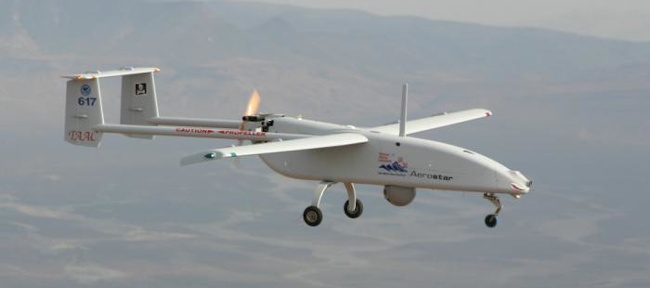Aeronautics RQ-26 Aerostar
The Israeli company Aeronautics Defense Systems introduced its Aerostar multi-mission UAV in 2000. The airframe layout is quite typical for UAVs of that time, with a center body housing the propulsion system and mission equipment, straight wings and a twin-boom tail assembly. For take-off and landing, it uses a conventional runway. It can be fitted with a wide variety of equipment and sensors for all kinds of ISR (Intelligence, Surveillance and Reconnaissance) missions. It has a GPS/INS navigation system for autonomous operations, and supports line-of-sight and satellite datalinks for remote control.
 |
| Photo: Aeronautics |
| Aerostar (RQ-26A) |
In 2013 or earlier, the U.S. Navy acquired at least two Aerostar UAVs for safe and efficient test and evaluation of UAV payloads, and support of other UAV test operations. The Navy's Aerostar drones were officially designated RQ-26A in 2014. Since 2018, they are operated, together with various other UAVs, by the newly established Test and Evaluation Squadron UX-24.
Specifications
Note: Data given by several sources show slight variations. Figures given below may therefore be inaccurate!
Data for Aerostar (RQ-26A):
| Length | 4.5 m (14.8 ft) |
| Wingspan | 8.7 m (28.5 ft) |
| Height | 1.3 m (4.3 ft) |
| Weight | 240 kg (530 lb) |
| Speed | 185 km/h (115 mph) |
| Ceiling | 5500 m (18000 ft) |
| Range | 250 km (155 miles) (line-of-sight datalink) |
| Endurance | 12 h |
| Propulsion | Zanzottera 498i two-stroke boxer engine; 28 kW (38 hp) |
Main Sources
[1] Israeli-Weapons.com: Aerostar
[2] Aeronautics: Aerostar
[3] Airforce Technology: Aerostar Tactical
Unmanned Aerial Vehicle
[4] Naval Technology: US NAVAIR trials GPS
anti-jamming device capability aboard Aerostar UAV
[5] NAVAIR: Test
and Evaluation Squadron (UX) 24
Back to Directory of U.S. Military Rockets and Missiles, Appendix 2
Last Updated: 25 January 2024